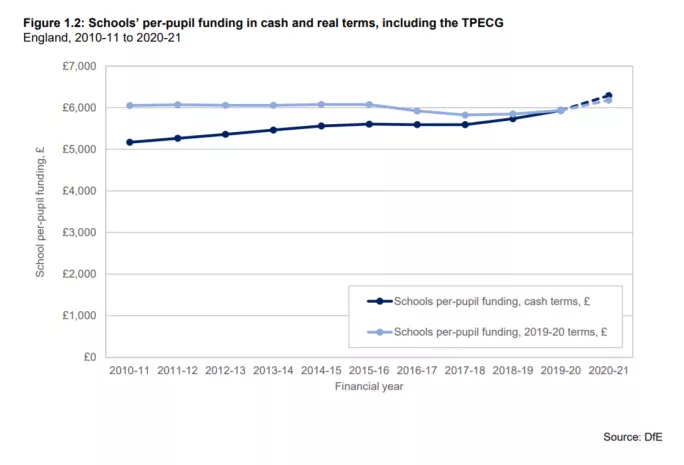The government has finally admitted that average per pupil school funding has fallen in real terms since 2010 - despite years of claims that spending is at record levels.
New figures published today by the Department for Education (DfE) shows that per pupil funding remained “broadly flat” between 2010-11 and 2015-16.
It then fell by 4.2 per cent over 2016-17 and 2017-18, and has subsequently increased by 1.9 per cent to the current level.
IFS: DfE ‘record school funding’ mantra ‘not helpful’
PM: New law means LAs must pass minimum funds to schools
Background: PM announces ‘giant £14 billion’ school funding boost
In 2019-20, average per pupil school funding stands at £5,940. That compares to £6,050 in 2010-11 in today’s terms - representing a 1.8 per cent decrease.
This means that per pupil funding has fallen in real terms since the beginning of the decade.
The government had previously insisted that school funding is at “record levels”.
In 2018, it came under fire from the independent Institute of Fiscal Studies (IFS) for claiming it is putting more money into schools than ever before.
When asked by Tes whether the repeated DfE mantra about “record funding” was helpful or disingenuous, Luke Sibieta, a research fellow at the IFS, said: “Just saying it’s at record levels doesn’t really help anyone. It’s important to see the full historical context and the challenges facing schools at the moment.”
Today’s DfE report references government plans to invest an extra £7.1 billion in schools in England over three years from 2020-21.
It states that per pupil funding is expected to rise to £6,180 next financial year - which is 2.1 per cent higher than the 2010-11 total, in real terms.
However, the DfE admits that without a rise in teacher pay and pension contributions it would actually amount to a real terms funding cut compared to 2010.
It says: “Excluding the TPECG [teachers’ pension employer contribution grant], per-pupil funding in 2020-21 would be 1.0 per cent lower than in 2010-11.”
Yesterday, the government announced that local authorities will be required by law to ensure all schools receive their minimum funding entitlements from next year.
The change in legislation means that in 2020-21, LAs will be responsible for guaranteeing at least £5,000 per pupil at secondary schools, and £3,750 (rising to £4,000 in 2021-22) per pupil at primary schools in their area.
Mary Bousted, joint general secretary of the NEU teaching union, said: “The government’s rhetoric is excellent, it is a pity the reality for the vast majority of schools does not match it.”
Prime minister Boris Johnson said: “Levelling up education is the key to helping every child reach their full potential.
“We’re guaranteeing the minimum level of funding for every pupil in every school so that, with a top class education, our children can go on to become the world’s future innovators, trailblazers and pioneers.
“As we start a new chapter in our history, our younger generations will be front and centre of all that we do.”





